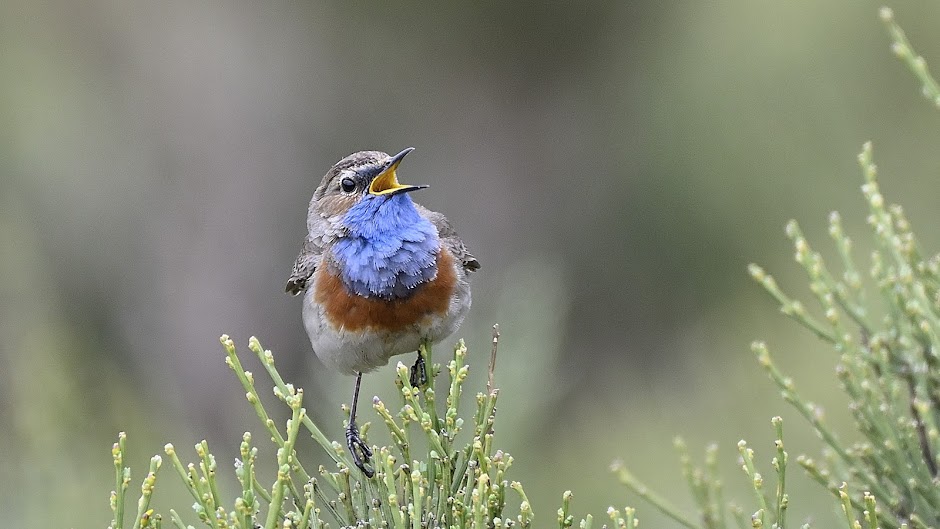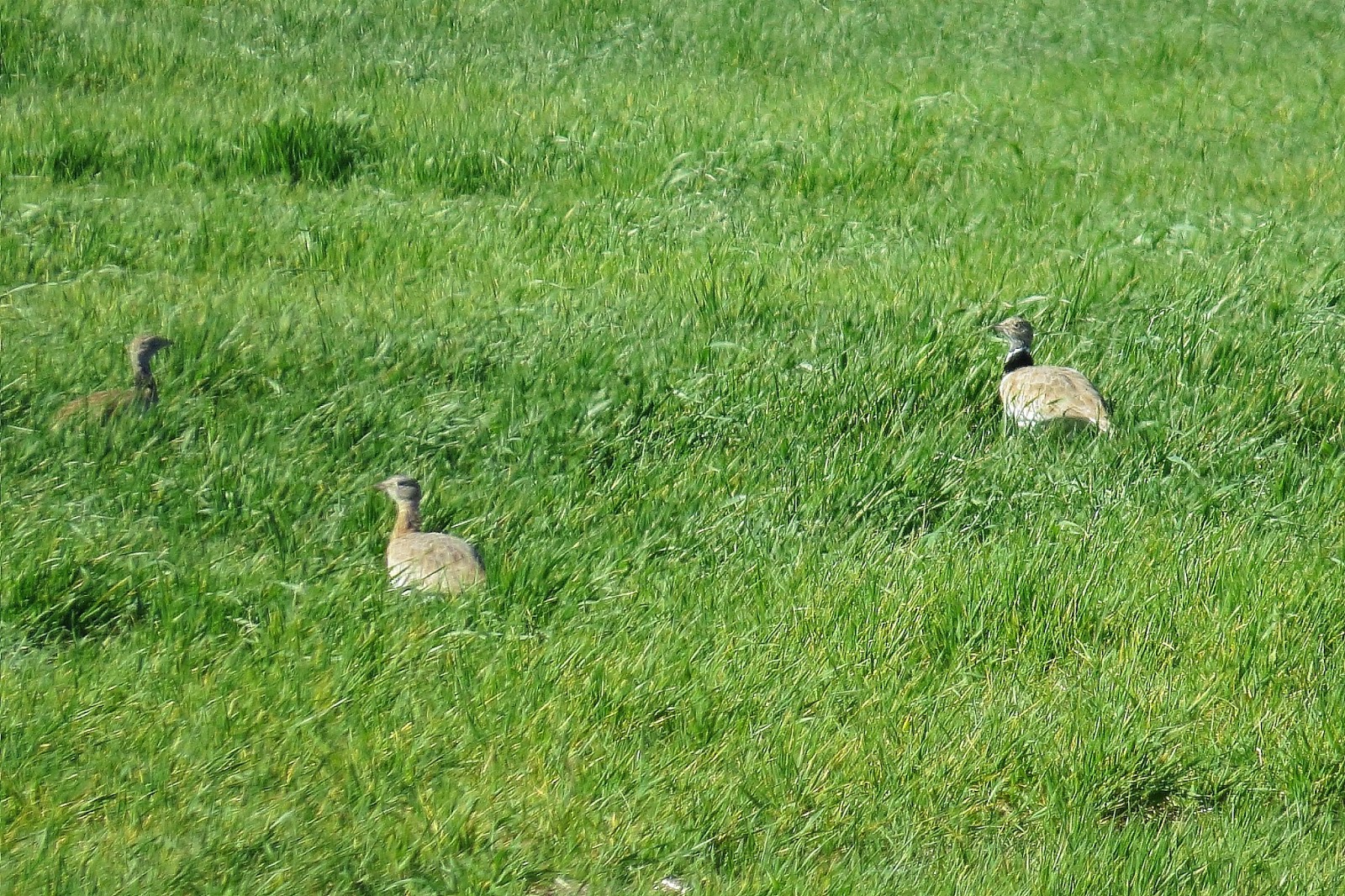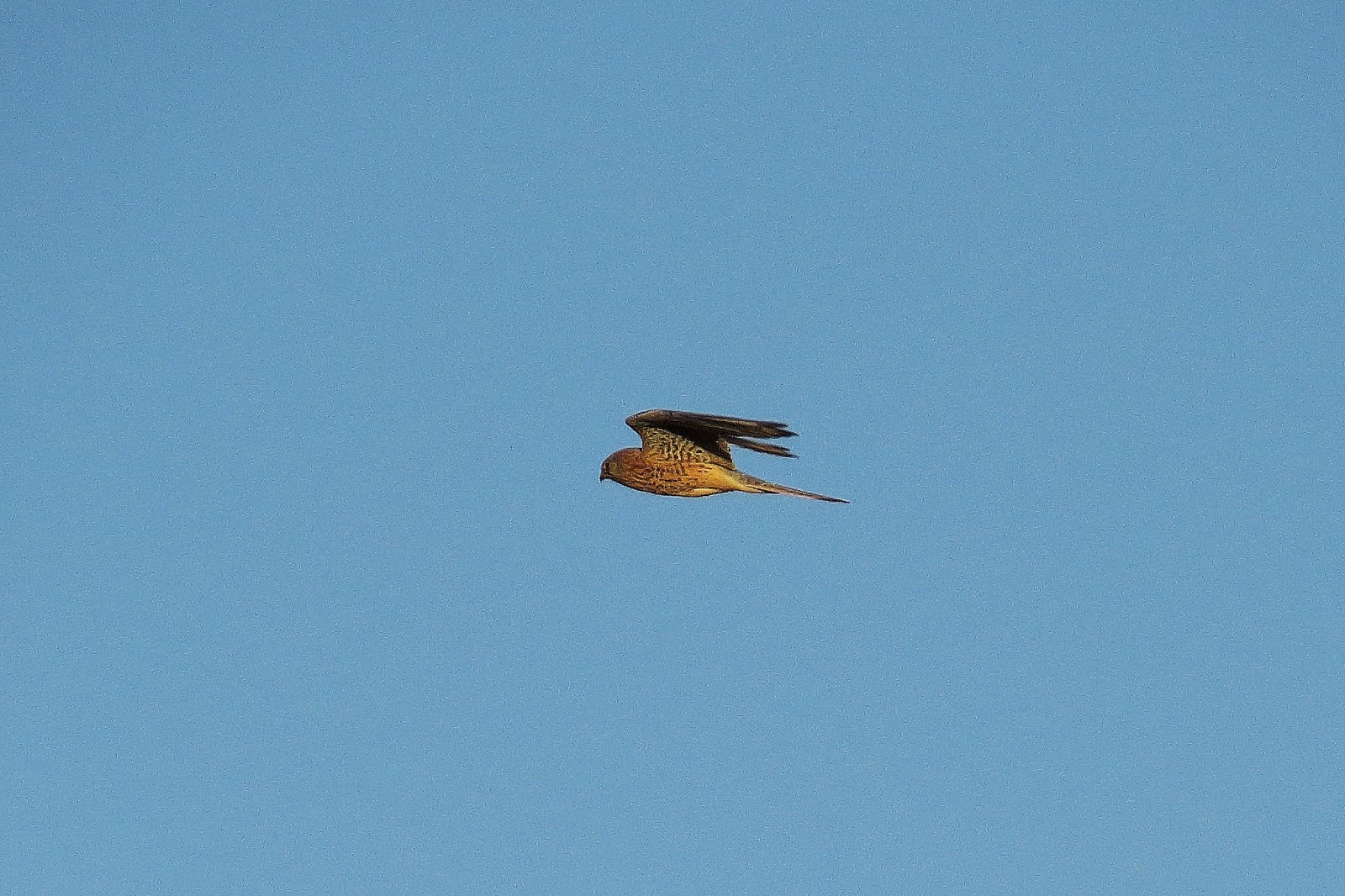Hola de nuevo.
Hello again.
Esta entrada pertenece a una excursión que realicé a primeros de marzo en la provincia de Toledo pues unos clientes querían ver aves esteparias.
This post belongs to a trip I made in early March in the province of Toledo as customers wanted to see Steppe Birds.
El tiempo no pudo ser mejor y disfrutamos de un maravilloso día de pajareo. Como resumen de la jornada vimos más de 350 sisones comunes, 150 avutardas comunes, 6 gangas ibéricas, 5 gangas ortega y más de 150 chorlitos dorados europeos. Nos faltaron los alcaravanes comunes que es esa zona no suelen verse. Además todo ello aderezado con infinidad de otras aves que nos entretuvieron durante todo el día.
The weather could not be better and we enjoyed a wonderful day of birding. As a summary of the day we saw over 350 Little Bustards, 150 Great Bustards, 6 Pin-tailed
Sandgrouse, Black-bellied
Sandgrouse 5 and 150 European Golden Plover. We missed the Stone-curlew which in that area is not usually seen. Furthermore all seasoned with many other birds that entertained us all day.
Comentaros que me extrañó bastante lo asustadizas que estaban las avutardas comunes que incluso permaneciendo en la furgoneta se alejaban volando a distancias en las que en otros lugares no se hubiesen espantado. Espero que no se esté dando caza ilegal desde los vehículos a estas aves protegidas.
As a comment I was surprised that the Great Bustards were so aware of car presence. They start to fly as soon as we stoped the van at a distances really far much longer than in other areas. I hope no body is hunting illegaly from the vehicles these protected birds.
Nada más llegar a la zona de pajareo nos llevamos una grata sorpresa al comprobar que los cernícalos primilla (Falco
naumanni) ya habían llegado a su colonia de cría. A la derecha está el macho.
Upon reaching the Birding Area we had a pleasant surprise to find that the Lesser Kestrels had already arrived at their breeding colony. Male is on the right.
Un macho de colirojo tizón (Phoenicurus
ochruros).
Black
Redstart male.
Un poco más adelante nos encontramos con el mayor bando de sisones comunes (Tetrax
tetrax) de todo el día. Sobrepasaban los 100 ejemplares. Ya se podían diferenciar los machos adultos con sus collares negros.
A little further we found with the greatest group of Little Bustards of all day. Exceeded 100 specimens. You could distinguish adult males with their black collars.
El bando se espantó pues había un agricultor rotulando un campo. Se dividió en varios grupos cuando empezaron a volar.
The group was frightened as there was a farmer plowing a field. It split into several groups when they start to fly.
Durante todo el día nos acompañaron los trigueros (Miliaria
calandra).
Throughout the day we were accompanied by Corn Buntings.
También pudimos observar varios aguiluchos pálidos (Circus cyaneus). El la foto un joven.
We also saw several Hen Harriers. In the photo a juvenile.
Y bastantes cogujadas comunes (Galerida
cristata).
And quite a few Crested Larks.
Otro gran bando de sisones comunes (Tetrax tetrax).
Another large flock of Little Bustards.
Las avutardas comunes (Otis tarda) no paraban de pasar cerca nuestro pero en vuelo.
The Great Bustards were passing close to us flying.
Este fue el grupo mayor.
This was the largest group.
Este grupo estaba a demasiada distancia para tomar una buena foto pero ya se veían algunos machos haciendo el cortejo.
This group was too far away to take a good photo but males were already doing courtship display.
También vimos perdices rojas (Alectoris
rufa) pero ya estaban separadas por parejas.
We also saw Red-legged Partridges all separated already in pairs.
Un macho adulto de aguilucho pálido (Circus cyaneus).
A Hen Harrier adult male.
Y no muy lejos suyo a este macho de gavilán común (Accipiter
nisus). Y aunque solo fugazmente vimos un esmerejon pero muy rápido para poder sacar una foto.
And not far from him we saw this Eurasian Sparrowhawk male. And although only briefly a Merlin but very fast to take a photo.
Al poco rato vimos este grupo de avefrías europeas (Vanellus
vanellus) que volaban conjuntamente con chorlitos dorados europeos (Pluvialis
apricaria).
Soon we saw this group of Northern Lapwings flying together with European Golden Plovers.
Vimos como primero se posaron las avefrías europeas (Vanellus vanellus) y los chorlitos dorados europeos (Pluvialis apricaria) no se decidieron hasta un rato más tarde.
We saw first landing the Northern Lapwings whereas the European Golden Plovers did not the same until a while later.
Cuando nos dirigíamos a ver si podíamos encontrar el grupo que se había posado vimos este milano real (Milvus
milvus).
While we were going to see if we could find the flock that has landed we saw this Red Kite.
Y a esta liebre (Lepus granatensis) macho que perseguía insistentemente a una hembra.
And a this Iberian Hare male insistently chasing a female.
Tuvimos suerte y el grupo de avefrías europeas (Vanellus vanellus) y de chorlitos dorados europeos (Pluvialis apricaria) se encontraba no muy lejos del carril y a una distancia suficiente para que pudiésemos observarles sin que se diesen a la fuga.
We were lucky and the group of Northern Lapwings and European Golden Plover was not far from the rail and a enough distance so that we could watch them without disturbing.
La más confiada del grupo.
The tamest of the group.
Unas palomas zuritas (Columba
oenas).
Some Stock
Doves.
Un poco alejados de donde habíamos visto el primer bando de sisones comunes (Tetrax tetrax) nos encontramos con este otro nutrido grupo pero como hacía calor y la siembra estaba alta no podría decir cuantos había con exactitud pero en un conteo rápido salieron 63.
Slightly away from where we had seen the first group of Little Bustards we find that other large one but as it was hot and planting was high I could not say exactly how many there were but in a quick count came out 63.
Después de disfrutar durante un rato de ellos volvimos a ponernos en marcha para ver si veíamos algunas gangas. En el camino vimos más cogujadas comunes (Galerida cristata).
After enjoying them for a while we went back to get going to see if we can spot some Sandgrouses. On the way we saw more Crested Larks.
En una pequeña charca cercana a un riachuelo había unas cuantas agachadizas comunes (Gallinago
gallinago).
In a small pond near a creek there were a few Common Snipe.
Compartiendo la charca también estaba este andarríos grande (Tringa
ochropus).
Sharing the pond was also a Green Sandpiper.
Las calandrias (Melanocorypha
calandra) cantaban sin cesar tanto posadas como en vuelo.
Calandra
Larks were singing continuously both on land and in flight.
Al poco rato volvimos a ver otro bando de chorlitos dorados europeos (Pluvialis apricaria) pero éste no estaba en compañía de avefrías europeas (Vanellus vanellus).
After a while we saw another group of European Golden Plover but this was not accompanied by Northern Lapwings.
De no ser por este chorlito que estaba solo y me extrañó, no hubiésemos visto:
If not for this Plover that was alone and surprised me, we had not seen:
a este grupo de gangas ibéricas (Pterocles
alchata). La verdad es que se me cruzaron al hacer un barrido con el telescopio terrestre.
this group of Pin-tailed Sandgrouse. The truth is that they crossed my telescope while making a sweep.
Que difíciles sois de ver posadas. En total había seis.
You are really difficult to spot when on land. There were six in total.
Y a continuación decidimos ir a ver si encontrábamos más avutardas comunes (Otis tarda) y vimos otro grupo de chorlitos dorados europeos (Pluvialis apricaria).
And then we decided to see if we could find Great Bustrds and we saw another group of European Golden Plover.
Hubo suerte aunque como siempre demasiado sensibles a nuestra presencia.
We were lucky although as always too sensitive to our presence.
También vimos 5 gangas ortega (Pterocles
orientalis) aunque siempre en vuelo y gracias a su insistente canto.
We also saw 5 Black-bellied Sandgrouse but always in flight and due to its insistent song.
Otro grupo. Este chorlito era el más cercano.
Another group. This Plover was the closest.
Y cuando decidimos que ya habíamos visto mas de lo esperado decidimos poner rumbo a casa. Un grupo de gorriones morunos (Passer
hispaniolensis) compartiendo almendro con un triguero (Miliaria
calandra) en la izquierda.
And when we decided that had seen more than expected we decided to head home. A group of Spanish Sparrows sharing an Almond Tree with a Corn Bunting on the right.
El triguero (Miliaria calandra) que se quedó más tiempo que los gorriones.
The Corn Bunting that stayed longer than Sparrows.
Y en nuestro punto de salida vimos que habían regresado los cernícalos primilla (Falco
naumanni) a su colonia.
And at our outgoing point we saw that Lesser Kestrels had returned to their colony.
Y con esta bella estampa me despido de vosotros hasta la próxima entrada.
And with this beautiful picture I say goodbye to you until the next post.


















































































No hay comentarios:
Publicar un comentario